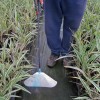 Bittercress commonly grows in the potting media of container-grown ornamentals and often through drainage holes in nursery containers. It also can be a problem in propagation houses, greenhouses, and in the field. This 6-page fact sheet provides species description, plant biology, and management recommendations. Written by Chris Marble, Shawn Steed, and Nathan S. Boyd, and published by the UF Department of Environmental Horticulture, December 2014.
Bittercress commonly grows in the potting media of container-grown ornamentals and often through drainage holes in nursery containers. It also can be a problem in propagation houses, greenhouses, and in the field. This 6-page fact sheet provides species description, plant biology, and management recommendations. Written by Chris Marble, Shawn Steed, and Nathan S. Boyd, and published by the UF Department of Environmental Horticulture, December 2014.
http://edis.ifas.ufl.edu/ep511
Tag: Shawn Steed
Floriculture Crops Economic Outlook for 2014
 This 15-page report summarizes industry statistics using data from primary and secondary sources and highlights production and sales trends in the US environmental horticulture industry in 2014. Data sources include the United States Department of Agriculture National Agricultural Statistics Service (USDA/NASS), US Census Bureau, the IBIS World Industry Reports, National Association of Home Builders, S&P/Case-Shiller Home Price Indices, US Bureau of Labor Statistics, University of Florida Bureau of Economic and Business Research, AIA Economics and Market Research Group, and Florida Realtors®. Primary data is collected through the National Nursery Survey, conducted by the Green Industry Research Consortium. Written by Hayk Khachatryan, Alan W. Hodges, and Shawn Steed, and published by the UF Department of Food and Resource Economics, March 2014.
This 15-page report summarizes industry statistics using data from primary and secondary sources and highlights production and sales trends in the US environmental horticulture industry in 2014. Data sources include the United States Department of Agriculture National Agricultural Statistics Service (USDA/NASS), US Census Bureau, the IBIS World Industry Reports, National Association of Home Builders, S&P/Case-Shiller Home Price Indices, US Bureau of Labor Statistics, University of Florida Bureau of Economic and Business Research, AIA Economics and Market Research Group, and Florida Realtors®. Primary data is collected through the National Nursery Survey, conducted by the Green Industry Research Consortium. Written by Hayk Khachatryan, Alan W. Hodges, and Shawn Steed, and published by the UF Department of Food and Resource Economics, March 2014.
http://edis.ifas.ufl.edu/fe941
Uso Apropiado y Manipulacion de Glifosato en Viveros de Plantas (ENH1209/EP470)
 El glifosato es el químico de protección para cultivos más vendido en el mundo y el herbicida mós usado en la industria de viveros de plantas en los Estados Unidos. El glifosato es usado para el control post emergente de malezas. Esta publicación describe el uso adecuado de glifosato para los productores de plantas y sus empleados. This 4-page fact sheet was written by Shawn T. Steed, Robert H. Stamps, and Rodrigo Diaz, and published by the UF Department of Environmental Horticulture, February 2013.
El glifosato es el químico de protección para cultivos más vendido en el mundo y el herbicida mós usado en la industria de viveros de plantas en los Estados Unidos. El glifosato es usado para el control post emergente de malezas. Esta publicación describe el uso adecuado de glifosato para los productores de plantas y sus empleados. This 4-page fact sheet was written by Shawn T. Steed, Robert H. Stamps, and Rodrigo Diaz, and published by the UF Department of Environmental Horticulture, February 2013.
http://edis.ifas.ufl.edu/ep470
Proper Use and Handling of Glyphosate in Plant Nurseries (ENH1198/EP459)
 Glyphosate is the most used herbicide in the nursery industry in the United States. Used for postemergent control of vegetation, it controls annual and perennial grasses, broadleaves, and sedges. But it is easy to cause unintended damage to desirable vegetation if this product is used incorrectly. This 4-page fact sheet outlines the proper use of glyphosate for plant producers and their employees. Written by Shawn T. Steed and Robert H. Stamps and published by the UF Department of Environmental Horticulture, May 2012.
Glyphosate is the most used herbicide in the nursery industry in the United States. Used for postemergent control of vegetation, it controls annual and perennial grasses, broadleaves, and sedges. But it is easy to cause unintended damage to desirable vegetation if this product is used incorrectly. This 4-page fact sheet outlines the proper use of glyphosate for plant producers and their employees. Written by Shawn T. Steed and Robert H. Stamps and published by the UF Department of Environmental Horticulture, May 2012.
http://edis.ifas.ufl.edu/ep459
Assessing Economic Impacts and Benefits of Commercial Horticulture Extension Programs (FE898)
 As fiscal pressures increase from federal and state government agencies to spend public dollars more effectively, it is imperative that the outcomes from educational efforts be clearly documented in terms of measurable changes in knowledge and behavior of clientele or stakeholders. This 5-page fact sheet presents a standardized approach for evaluating the economic impacts of extension educational programs in commercial horticulture in Florida, with which impacts are quantified in terms of measurable changes in revenues, income, or jobs. Written by Alan Hodges, Shawn Steed, Jane Morse, Peggy Dessaint, Donald Rainey, and Charles Vavrina, and published by the UF Department of Food and Resource Economics, September 2011. (AP Photo:Thomas Wright, University of Florida/IFAS)
As fiscal pressures increase from federal and state government agencies to spend public dollars more effectively, it is imperative that the outcomes from educational efforts be clearly documented in terms of measurable changes in knowledge and behavior of clientele or stakeholders. This 5-page fact sheet presents a standardized approach for evaluating the economic impacts of extension educational programs in commercial horticulture in Florida, with which impacts are quantified in terms of measurable changes in revenues, income, or jobs. Written by Alan Hodges, Shawn Steed, Jane Morse, Peggy Dessaint, Donald Rainey, and Charles Vavrina, and published by the UF Department of Food and Resource Economics, September 2011. (AP Photo:Thomas Wright, University of Florida/IFAS)
http://edis.ifas.ufl.edu/fe898